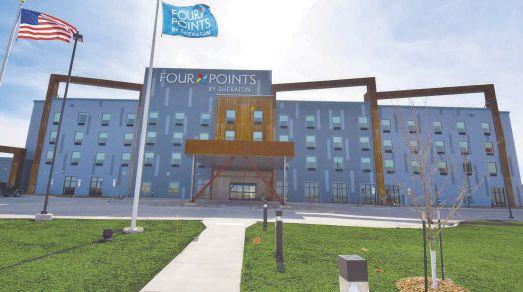
7 minute read
‘All the Right Pieces’
In Grand Forks, N.D., and East Grand Forks, Minn., the country’s first unmanned aircraft park is the big news, but the Community Profile roundtable discussion also highlighted the nearby Air Force Base, tourism, the exchange rate and collaboration to solve the workforce shortage
BY KAYLA PRASEK
It’s a busy time of growth and development in Grand Forks, N.D., and East Grand Forks, Minn., the site of Prairie Business’ third Community Profile. In a roundtable discussion with city, business and organization leaders, Prairie Business learned more about Grand Sky, the country’s first unmanned aircraft systems business and aviation park, and the cities’ role at the forefront of the UAS movement, the workforce shortage and efforts to solve it, and economic development efforts in the region.
Several organizations are in the midst of major construction projects, while the Grand Forks Region Economic Development Corp. has several potential companies on its radar. “The biggest story is Grand Sky,” says Keith Lund, EDC vice president. “Northrop Grumman is completing their facility (at Grand Sky), and it will be completed later this year, while General Atomics has a temporary hangar and will be finishing a permanent hangar. MinnKota (Power Cooperative) is completing their new campus, and the EDC is pursuing two agribusiness companies. We’re also still working with Northern Plains Nitrogen, who is seeking a primary funding partner to build here.”
Tom Kenville, chairman of UAI International, calls Grand Forks “the pulse” of the UAS industry “with all the right pieces here.” There are four phases of build out at Grand Sky, and those behind the project expect 1,000 people to eventually work out of the business park. Kenville says those jobs will be created by 15 to 20 businesses, plus many spin-off businesses. “These businesses can go wherever in the world they want, but they’ve chosen Grand Forks,” Kenville says. “We have a lower population, which means better communication with our politicians, plus we have partnerships with the Grand Forks Air Force Base, the state, local government, (the University of North Dakota) and (Northland Community & Technical College)."
The public-public-private partnership that helped bring Grand Sky to life is “visionary,” says Chris Wolf, market president for the northern valley at Alerus. “That collaboration with a lot of groups coming together is impressive,” Wolf says. Barry Wilfahrt, president and CEO of The Chamber of Grand Forks-East Grand Forks, notes the many firsts that Grand Forks accomplished in the UAS industry. “We had the first UAS park, the first UAS degree, the first location that had a UAS flight that did not have a chase plane in non-restricted airspace and the first operational test site. It’s all part of a bigger story, as the community worked together to make it happen.”

Workforce Development
In order to make Grand Sky a success, Wilfahrt says the two current tenants, Northrop Grumman and General Atomics, are looking for their staff to be 50 to 60 percent local hires. “The real key is, can we get those people to move here and can we fill those positions?”
On the flip side, Lund says bringing in 40 to 50 percent of staff is not a bad thing. “We need more people. A lot of the new hires will be from UND, NCTC, the Air (National) Guard, but they’ll bring in people from around the country and they’ll bring their families with them.”
While Grand Sky doesn’t necessarily have workforce shortage issues yet, other companies and organizations in Grand Forks and East Grand Forks are facing those shortages. Dave Molmen, CEO at Altru Health System, says “health care progressively in our country is probably going to be facing workforce challenges for decades to come,” which he attributes to the aging population in the U.S., and says Altru is no exception. Molmen says workforce has been challenging, especially in areas where the health care system competes across the country for professionals, such as doctors and nurses.
Bill Burga Jr., senior project director of global operations at LM Wind Power, says workforce wasn’t an issue until about two years ago. “A year and a half ago, we went outside our market looking for people for the first time. We’ve got commitments but we need the workforce to meet our commitments, so we sat down and said we need to do something and expanded where we were looking for people. That didn’t (solve) it, but it started the flow. It’s a good problem to have.”
The oil slowdown in western North Dakota hasn’t brought an influx of people into the workforce either. Tal Elseth, plant director at J.R. Simplot Co., says Simplot picked up a few in supervisor areas, but hasn’t seen an increase in those applying for hourly positions. “Our biggest issue is we’re 24-7 and people don’t want to work overnight shifts anymore.”
To help solve the workforce problem, Altru is “not just recruiting people, but trying to train more people,” Molmen says. “We’re going into Grand Forks and East Grand Forks schools, doing health awareness and hosting health career fairs. We also have great partnerships with UND and NCTC. We’re going to compete across the country, but the most effective thing we can do is grow it here because they’re people who like it here and have a strong work ethic.”
Wolf says Alerus has gone the same route as Altru, focusing on having a relationship with the students by being present at career expos, bringing in students to job shadow and promoting experiential learning and internships. Lund says the EDC has focused on career awareness, starting with Junior Achievement in the elementary schools and continuing through high school career expos. “It’s about getting someone connected to a job and keeping them here,” Lund says. “We need to do as good of a job as we can to keep those students around.”
Peter Johnson, interim vice president for university and public affairs at UND, and Maureen Storstad, director of finance for the City of Grand Forks, say those two entities joined forces for an internship program as well. “The city’s internship program has been great to create that bridge,” Johnson says. “It helps (our students) see the types of opportunities available. There’s been more of an emphasis on experiential learning at UND in the past 10 years with a greater focus on pushing them out the door to get their feet wet so they see there are opportunities here.”
Storstad says the internship program allows the interns to see different areas of a government job with benefits to both the city and the student. In East Grand Forks, Paul Gorte, economic development direc- tor, says the city tries to have at least one intern, who learns about all the different offices and the range of what city government does. Gorte says the City of East Grand Forks works closely with NCTC. “It’s important because it’s a tremendous asset,” Gorte says.
Economic Development

As part of the effort to grow the city’s workforce, Grand Forks Mayor Michael Brown has focused on the city’s vibrancy through three committees dedicated to the arts, downtown and the city’s relationship with UND. “We’ve really looked at the downtown as an asset for our community and had discussions of how to make it better and more enjoyable for a larger group of people,” says Wolf, who is a member of the downtown committee. “We’ve looked at walkability and the possibility of having more things to do downtown.”
While the city focuses on attracting and retaining students and professionals, there’s also a renewed focus on attracting tourists. “The Canadian dollar is a definite struggle for us,” says Julie Rygg, executive director of the Greater Grand Forks Convention & Visitors Bureau. “We know Canadians are traveling here less often, but they still like coming here. They like to eat out, shop and stay for the weekend. … We know at some point it will turn around again.”
As a side effect of the slowed tourism, hotel occupancy is down but the city also has a larger inventory of rooms than it has had in the past. Gorte says the campgrounds in East Grand Forks are full for the year, which he believes means tourism is picking up again.
The agriculture industry is also seeing some struggles, though Elseth says Simplot hasn't felt those effects. “We contract all of our crop every year. What we’re seeing is that potato prices are holding, but with other prices down, people want to get into potatoes so it’s helping us. On our commodity sides, they’re definitely seeing low prices and low profits because of the ag market.” Wolf says Alerus’ ag bankers have noticed their customers are still doing well, but not as well as they were three to four years ago.
Grand Forks continues to reap the benefits of the Grand Forks Air Force Base, which had a $220 million economic impact on the region in 2015, and the city was recognized as one of the top 10 defense communities this year. Wilfahrt and Gorte both say the community embraces the base in a way most communities with Air Force Bases don’t.

“I’ve been doing this for 13 years, and this is the one location that the ties between the community and the base are stronger than anywhere I’ve been, and I’ve been here nine months,” says Shaun Shenk, Grand Forks Air Force Base’s chief of public affairs. “The involvement and the way (the city) wants to nurture it and take it another step further is amazing. … We’re a reflection of the community we’re in. We can go to the community for an issue we’re having, and that’s invaluable to me, in my position, and to Col. (Rodney) Lewis, (base commander). That’s changing lives, when you can go to a community with a problem that they can fix.”
Wilfahrt and Gorte both mention their cities’ work toward creating healthy startup environments as well. “The good environment for entrepreneurs has been intentional,” Wilfahrt says. “We’re still working toward making it a better startup community, and we’re getting ready to have a meeting to bring all the partners together to see where the gaps are and how we can fill them in.” Gorte says East Grand Forks has focused on the many resources available from the state of Minnesota, especially as the city has seen more inquiries about starting businesses come in.
The cities have also made “tremendous strides forward in infrastructure,” Wilfahrt says, including UND’s med school and law school, the ICON Sports Center and Choice Health & Fitness. “We’re really in a good position.” The city’s top priority now is a water treatment plant, which is “absolutely viable for companies like Simplot. Keeping a company like that economically healthy is necessary,” he says. PB

Kayla Prasek Staff Writer, Prairie Business 701.780.1187
kprasek@prairiebusinessmagazine.com











